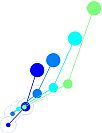Directional biases in behaviour and limb use are evident across the animal kingdom – from primates to insects. These biases are referred to as lateralisation, or more colloquially, ‘handedness'. However, despite the prevalence of such motor properties, the functional and ecological advantage(s) they confer is still not entirely clear. Proposed benefits of lateralisation have largely been considered in social contexts, useful for coordinating behaviours with conspecifics (Niven & Frasnelli (2018) Prog. Brain. Res. 238: 3-31). In non-social contexts, particularly for insects, it has been argued that a directional motor specialization may confer advantages in the performance of specific actions or motor control tasks (Niven & Bell (2018) Trends Ecol. Evol. 33(7)). This hypothesis remains to be quantified and tested in a continuous fine-tuned motor task, such as using a limb to track a moving target.
An ideal behaviour to investigate the function of lateralisation in continuous motor tasks in insects is the nutrient-seeking behaviours of pollinating insects, as they search for flower nectaries (see Kannegieser et al. (2024) PNAS 121(6)). While foraging, the hummingbird hawkmoth (Macroglossum stellatarum) uses visual pattern features for continuous guidance of its proboscis to locate a flower's nectary. Using pose estimation (DeepLabCut) on freely-flying hawkmoths, we find a range of individual-level lateralisation in proboscis placement during artificial flower pattern inspection. Moreover, individual biases appear largely consistent across consecutive days of testing, suggesting that individuals may develop idiosyncratic proboscis control strategies for flower inspection. As the observed lateralisation can arise from sensory biases (e.g. eye dominance), we combine manipulative behavioural experiments and quantitative behavioural analyses to elucidate whether viewing patterns with a preferred eye drives proboscis lateralisation. This work offers new insights into the lateralisation of continuous fine-tuned motor tasks, visuo-motor biases of a centrally-positioned appendage, and hawkmoth foraging behaviour. Using these insights, we seek to understand the functional implications of such biases on hawkmoth flower interactions, such as information acquisition, decision-making, and foraging efficiency.

 PDF version
PDF version
